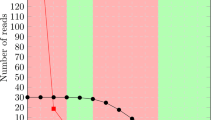Abstract
Resolving the correct structure and succession of highly similar sequence stretches is one of the main open problems in genome assembly. For non haploid genomes this includes determining the sequences of the different haplotypes. For all but the smallest genomes it also involves separating different repeat instances. In this paper we discuss methods for resolving such problems in third generation long reads by classifying alignments between long reads according to whether they represent true or false read overlaps. The main problem in this context is the high error rate found in such reads, which greatly exceeds the variance between the similar regions we want to separate. Our methods can separate read classes stemming from regions with as little as \(1\%\) difference.
Access this chapter
Tax calculation will be finalised at checkout
Purchases are for personal use only
Similar content being viewed by others
References
Myers, G.: Efficient local alignment discovery amongst noisy long reads. In: Brown, D., Morgenstern, B. (eds.) WABI 2014. LNCS, vol. 8701, pp. 52–67. Springer, Heidelberg (2014). https://doi.org/10.1007/978-3-662-44753-6_5
Tischler, G., Myers, E.W.: Non hybrid long read consensus using local de bruijn graph assembly. bioRxiv (2017). https://www.biorxiv.org/content/early/2017/02/06/106252
Patterson, M., Marschall, T., Pisanti, N., van Iersel, L., Stougie, L., Klau, G.W., Schönhuth, A.: WhatsHap: haplotype assembly for future-generation sequencing reads. In: Sharan, R. (ed.) RECOMB 2014. LNCS, vol. 8394, pp. 237–249. Springer, Cham (2014). https://doi.org/10.1007/978-3-319-05269-4_19
Murray, P., et al.: Whatshap: weighted haplotype assembly for future-generation sequencing reads. J. Comput. Biol. 22(6), 498–509 (2015). https://doi.org/10.1089/cmb.2014.0157. pMID: 25658651
Martin, M., et al.: Whatshap: fast and accurate read-based phasing. bioRxiv (2016). https://www.biorxiv.org/content/early/2016/11/14/085050
Bansal, V., Halpern, A.L., Axelrod, N., Bafna, V.: An MCMC algorithm for haplotype assembly from whole-genome sequence data. Genome Res. 18(8), 1336–1346 (2008). http://genome.cshlp.org/content/18/8/1336.abstract
Bansal, V., Bafna, V.: Hapcut: an efficient and accurate algorithm for the haplotype assembly problem. Bioinformatics 24(16), i153–i159 (2008). https://doi.org/10.1093/bioinformatics/btn298
Mazrouee, S., Wang, W.: Fasthap: fast and accurate single individual haplotype reconstruction using fuzzy conflict graphs. Bioinformatics 30(17), i371–i378 (2014). btu442[PII], http://www.ncbi.nlm.nih.gov/pmc/articles/PMC4147895/
Deng, F., Cui, W., Wang, L.: A highly accurate heuristic algorithm for the haplotype assembly problem. BMC Genomics 14(2), S2 (2013). https://doi.org/10.1186/1471-2164-14-S2-S2
Chin, C.S., et al.: Phased diploid genome assembly with single-molecule real-time sequencing. Nat. Methods 13, 1050 EP (2016). https://doi.org/10.1038/nmeth.4035. article
Chaisson, M.J., Mukherjee, S., Kannan, S., Eichler, E.E.: Resolving multicopy duplications de novo using polyploid phasing. In: Sahinalp, S.C. (ed.) RECOMB 2017. LNCS, vol. 10229, pp. 117–133. Springer, Cham (2017). https://doi.org/10.1007/978-3-319-56970-3_8
Koren, S., Walenz, B.P., Berlin, K., Miller, J.R., Bergman, N.H., Phillippy, A.M.: Canu: scalable and accurate long-read assembly via adaptive k-mer weighting and repeat separation. Genome Res. 27(5), 722–736 (2017). http://genome.cshlp.org/content/27/5/722.abstract
Carneiro, M.O., Russ, C., Ross, M.G., Gabriel, S.B., Nusbaum, C., DePristo, M.A.: Pacific biosciences sequencing technology for genotyping and variation discovery in human data. BMC Genomics 13(1), 375 (2012). https://doi.org/10.1186/1471-2164-13-375
Escalona, M., Rocha, S., Posada, D.: A comparison of tools for the simulation of genomic next-generation sequencing data. Nat. Rev. Genet. 17(8), 459–469 (2016). 27320129[pmid]. http://www.ncbi.nlm.nih.gov/pmc/articles/PMC5224698/
Ono, Y., Asai, K., Hamada, M.: Pbsim: Pacbio reads simulator-toward accurate genome assembly. Bioinformatics 29(1), 119–121 (2013). https://doi.org/10.1093/bioinformatics/bts649
Garrison, E., Marth, G.: Haplotype-based variant detection from short-read sequencing. ArXiv e-prints (2012)
Acknowledgments
We thank Gene Myers for interesting algorithmical discussions related to this paper and Shilpa Garg for advice on running WhatsHap.
Author information
Authors and Affiliations
Corresponding author
Editor information
Editors and Affiliations
Rights and permissions
Copyright information
© 2019 Springer Nature Switzerland AG
About this paper
Cite this paper
Tischler-Höhle, G. (2019). Haplotype and Repeat Separation in Long Reads. In: Bartoletti, M., et al. Computational Intelligence Methods for Bioinformatics and Biostatistics. CIBB 2017. Lecture Notes in Computer Science(), vol 10834. Springer, Cham. https://doi.org/10.1007/978-3-030-14160-8_11
Download citation
DOI: https://doi.org/10.1007/978-3-030-14160-8_11
Published:
Publisher Name: Springer, Cham
Print ISBN: 978-3-030-14159-2
Online ISBN: 978-3-030-14160-8
eBook Packages: Computer ScienceComputer Science (R0)




